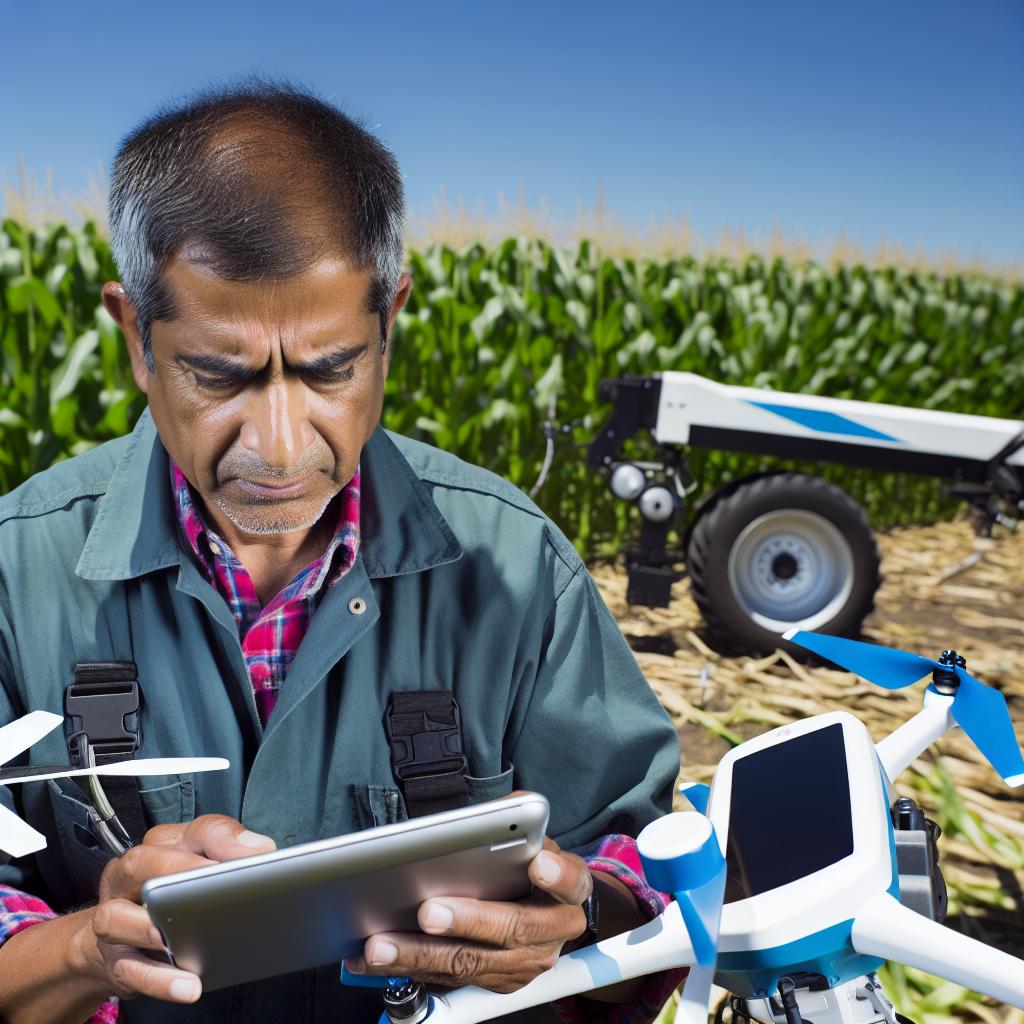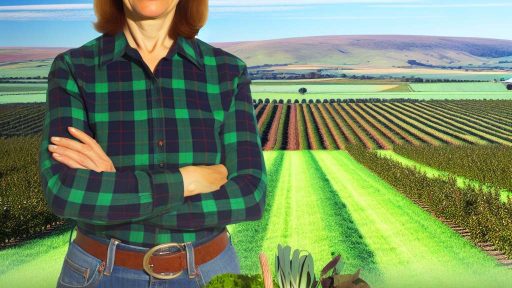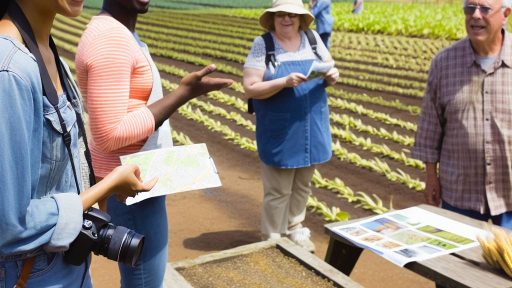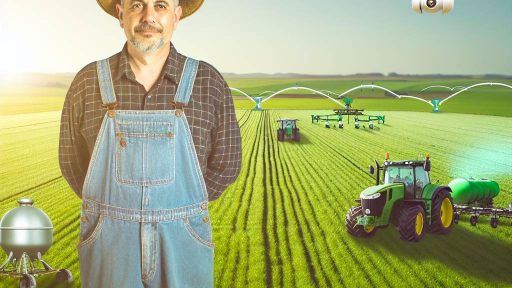Introduction to Precision Agriculture and Its Importance in Cost Reduction
Precision agriculture has transformed farming practices significantly.
This innovative approach utilizes data-driven technologies.
It increases efficiency while minimizing waste.
Farmers can now make informed decisions based on accurate data.
Consequently, they can optimize resource allocation effectively.
Additionally, precision agriculture helps reduce operational costs.
Farmers can track crop health and soil conditions in real time.
This monitoring allows for targeted interventions.
As a result, inputs like fertilizers and pesticides are used judiciously.
Furthermore, precision agriculture promotes sustainable practices.
By minimizing excess use of resources, it benefits the environment.
This holistic approach not only boosts productivity but also profitability.
Precision agriculture is crucial for cost reduction.
It lays the groundwork for a more efficient agricultural future.
Overview of Key Precision Agriculture Tools
GPS Technology
GPS technology enhances farming precision significantly.
Transform Your Agribusiness
Unlock your farm's potential with expert advice tailored to your needs. Get actionable steps that drive real results.
Get StartedFarmers utilize GPS for accurate field mapping.
This tool aids in efficient resource allocation.
Additionally, it helps track equipment and livestock locations.
Remote Sensing
Remote sensing gathers data without physical contact.
Farmers use satellites and drones for aerial imaging.
This technology monitors crop health and land conditions.
Moreover, it provides insights into irrigation needs.
Soil Sensors
Soil sensors provide real-time data about soil conditions.
They help farmers assess soil moisture and nutrient levels.
With this information, farmers optimize fertilization practices.
This leads to healthier crops and reduced waste.
Variable Rate Technology
Variable rate technology tailors inputs to specific field areas.
This approach reduces operational costs effectively.
Farmers apply seeds, fertilizers, and pesticides precisely.
Consequently, they enhance yields while minimizing environmental impact.
Farm Management Software
Farm management software streamlines data management.
This tool integrates various aspects of farm operations.
Farmers access financial, operational, and inventory data easily.
Furthermore, it assists in decision-making and improves efficiency.
Impact of GPS Technology on Crop Management and Cost Savings
Precision Farming Applications
GPS technology offers significant benefits in precision farming.
Farmers can accurately map fields for efficient resource use.
Additionally, equipment can operate with pinpoint precision.
This reduces overlaps and minimizes waste during operations.
Enhanced Crop Monitoring
With GPS, farmers can monitor crop health effectively.
Showcase Your Farming Business
Publish your professional farming services profile on our blog for a one-time fee of $200 and reach a dedicated audience of farmers and agribusiness owners.
Publish Your ProfileThey can gather detailed data on soil health and moisture levels.
Above all, this information helps manage inputs like water and fertilizers.
Consequently, it leads to better crop yields and reduced costs.
Improved Equipment Management
GPS facilitates better management of agricultural machinery.
This technology enables optimal routes for fieldwork tasks.
As a result, it decreases fuel consumption significantly.
In turn, farmers experience lower operational expenses.
Data-Driven Decision Making
GPS technology harnesses data for informed farming decisions.
Farmers can analyze historical data to improve future practices.
This leads to more effective resource allocation.
Moreover, it helps in forecasting yields and market trends.
Collaboration with Technology Providers
Farmers benefit from partnerships with technology providers.
Companies like AgriTech Innovations offer tailored GPS solutions.
These partnerships enhance productivity and streamline operations.
Furthermore, they provide ongoing support and training for farmers.
Delve into the Subject: Sustainable Diversification Methods for Contemporary Farmers
Use of Drones for Monitoring and Data Collection
Enhancing Efficiency
Drones significantly improve the efficiency of agricultural operations.
They can cover large areas in a short amount of time.
This reduces the need for manual labor and saves time.
Additionally, drones can access hard-to-reach areas easily.
They enhance field scouting and monitoring processes.
Data Collection Advantages
Drones provide high-resolution imagery for analysis.
This data helps farmers make informed decisions.
They can capture multispectral and thermal images.
This information is crucial for assessing crop health.
Farmers can identify issues like nutrient deficiencies quickly.
Cost Reduction Strategies
Implementing drone technology reduces operational costs.
This includes savings on fuel and labor expenses.
Drones can optimize inputs such as fertilizers and pesticides.
Farmers can use precise application methods effectively.
Moreover, they help in planning irrigation schedules accurately.
Real-World Applications
Several farms have successfully integrated drones into their operations.
For instance, GreenField AgriTech utilizes drones for crop monitoring.
They report a 20% reduction in operational costs after implementation.
Similarly, HarvestSky uses drones to assist in crop mapping.
This technology enhances their yield predictions significantly.
Future Potential
The future of drone technology in agriculture looks promising.
As technology advances, drones will become more affordable.
Farmers will be able to access better data analytics capabilities.
This will further streamline operations and improve crop yields.
Showcase Your Farming Business
Publish your professional farming services profile on our blog for a one-time fee of $200 and reach a dedicated audience of farmers and agribusiness owners.
Publish Your ProfileWith continued research, drones will play a vital role in precision agriculture.
Discover More: Creating Memorable Farm Stays To Boost Agritourism Appeal
Soil Sensors: Detecting Nutrient Deficiency to Reduce Fertilizer Costs
Understanding Soil Sensors
Soil sensors measure the nutrient levels in the ground.
They provide real-time data on soil conditions.
This technology helps farmers make informed decisions.
Consequently, they can optimize fertilizer applications.
Benefits of Soil Sensors
Farmers can reduce fertilizer costs effectively.
By detecting nutrient deficiencies early, they apply only what is needed.
This targeted approach minimizes waste significantly.
Moreover, it enhances crop health and yields.
Types of Soil Sensors
- Electrical conductivity sensors evaluate nutrient levels.
- Optical sensors assess soil moisture and composition.
- Heat pulse sensors measure soil temperature variations.
Implementing Soil Sensors in Agriculture
Farmers can integrate sensors easily into traditional farming systems.
First, they need to identify the right type of sensor.
Next, proper installation ensures accurate readings.
Training staff on interpreting data is essential.
Choosing the Right Sensor
Different crops may require specific sensor types.
For instance, certain plants may need continuous monitoring.
Other crops can benefit from periodic soil assessments.
Case Studies: Successful Adoption of Soil Sensors
Many farmers have reported significant savings after implementing soil sensors.
For example, Green Valley Farms saved up to 30% on fertilizer costs.
They achieved higher yields due to precise nutrient management.
Real-World Impacts
In addition to cost savings, environmental benefits arise.
Less fertilizer runoff leads to healthier ecosystems.
Hence, soil sensors contribute to sustainable farming practices.
See Related Content: Essential Record Keeping Practices To Ensure Farm Financial Success
Variable Rate Technology in Planting and Fertilization Strategies
Introduction to Variable Rate Technology
Variable Rate Technology (VRT) optimizes planting and fertilization.
This technology allows farmers to apply inputs based on specific field conditions.
As a result, farmers can achieve better yields while reducing waste.
Benefits of VRT
VRT significantly decreases operational costs.
It minimizes the over-application of fertilizers and seeds.
Consequently, farmers can save money and resources.
Additionally, VRT promotes higher crop productivity.
Using this technology leads to improved soil health over time.
How VRT Works
VRT utilizes data from soil and crop sensors.
This data informs farmers about varying conditions across their fields.
Farmers can employ this information to tailor their planting strategies.
For instance, using different seeding rates for distinct zones is common.
Moreover, VRT adjusts fertilizer applications for each section of the field.
Implementing VRT in Farming Practices
To adopt VRT, farmers start with comprehensive soil testing.
They analyze nutrient levels and moisture content across fields.
This data serves as a foundation for variable applications.
Showcase Your Farming Business
Publish your professional farming services profile on our blog for a one-time fee of $200 and reach a dedicated audience of farmers and agribusiness owners.
Publish Your ProfileFarmers can then incorporate VRT software into their existing systems.
Such software helps in planning and executing planting strategies efficiently.
Challenges of VRT Adoption
Despite the benefits, challenges exist in implementing VRT.
Initial costs for technology and software can be significant.
Additionally, training is required for farmers to adapt to new systems.
Furthermore, access to reliable data sources is essential for effectiveness.
Addressing these challenges can enhance the adoption rate among farmers.
Learn More: Ensuring Safety And Compliance In Agritourism Enterprises

Data Analytics in Precision Agriculture
Making Informed Decisions to Cut Costs
Data analytics plays a crucial role in precision agriculture.
Farmers now leverage technology to collect valuable data.
This data helps them make informed decisions quickly.
As a result, they can reduce operational costs effectively.
Analyzing Soil Health
Understanding soil health is essential for successful farming.
Data analytics allows farmers to assess soil conditions accurately.
They can identify nutrient deficiencies and adjust accordingly.
This leads to better crop yields and lower input costs.
Optimizing Resource Usage
Data-driven insights help optimize resource usage on farms.
This includes water, fertilizers, and pesticides.
Farmers can apply resources more efficiently based on data.
Consequently, they minimize waste and cut expenses.
Enhancing Crop Management
Data analytics can improve overall crop management strategies.
Farmers can monitor crop growth in real-time with technology.
They receive alerts regarding potential issues affecting crops.
As a result, they can act quickly to prevent losses.
Predictive Analytics for Future Planning
Predictive analytics is vital for planning future farming activities.
Farmers analyze historical data to forecast trends.
They can make better decisions based on anticipated market conditions.
This foresight helps them allocate resources effectively.
Integration of IoT and Big Data
The integration of IoT devices transforms how farmers analyze data.
Sensors collect real-time data from the fields continuously.
Big data allows for processing vast amounts of information quickly.
This leads to more accurate and timely decisions.
Implications of Data-Driven Practices on Cost Reduction
Utilizing data analytics effectively leads to significant cost reductions.
Farmers can streamline operations and increase profitability.
Ultimately, data-driven decisions ensure sustainable agricultural practices.
Case Studies: Successful Implementation of Precision Tools Leading to Cost Reduction
FarmSmart Technologies
FarmSmart Technologies implemented precision agriculture tools on a 1,500-acre farm.
By utilizing GPS-guided tractors and drones, they significantly increased efficiency.
As a result, labor costs dropped by 30% over two growing seasons.
Crop yields improved due to targeted planting and fertilization strategies.
This farm now enjoys a healthier bottom line and sustainable practices.
Showcase Your Farming Business
Publish your professional farming services profile on our blog for a one-time fee of $200 and reach a dedicated audience of farmers and agribusiness owners.
Publish Your ProfileGreenField Farms
GreenField Farms adopted soil monitoring sensors across their agricultural land.
This technology provided real-time data about soil conditions.
Consequently, they optimized irrigation schedules, reducing water usage by 40%.
Overall, operational costs decreased, allowing a reinvestment into farm innovation.
These changes have contributed to long-term viability for their farming business.
AgriTech Innovations
AgriTech Innovations focused on precision planting technology in row crops.
They implemented variable rate planting systems to match seed density with field variability.
This strategy minimized seed waste, resulting in a 20% cost reduction in seed expenses.
Additionally, their crop resilience improved through better plant spacing.
AgriTech can now increase profit margins while maintaining production sustainability.
Sunnyvale Orchards
Sunnyvale Orchards utilized yield mapping technology to assess their fruit crops.
By analyzing data, they identified underperforming sections of their orchards.
They then adjusted their cultivation practices accordingly, enhancing overall yield.
This targeted approach increased profits while minimizing unnecessary expenditures.
Sunnyvale Orchards demonstrates how data-driven decisions lead to effective solutions.
Precision Irrigation Solutions
Precision Irrigation Solutions offers crop-specific irrigation systems.
These systems apply water directly where needed, maximizing efficiency.
Farmers using this technology saw a reduction in water costs of up to 35%.
Moreover, better water management enhanced overall crop quality.
Such advancements significantly impact long-term agricultural sustainability and profitability.
Future Trends in Precision Agriculture Tools and Their Economic Implications
The Rise of Smart Farming Technologies
Smart farming technologies are transforming the agriculture sector.
Farmers increasingly adopt drone technology for crop monitoring.
These drones provide real-time data on plant health and soil conditions.
Additionally, sensors placed in fields capture essential environmental data.
This data helps farmers make informed decisions, improving efficiency.
Data Analytics and Machine Learning
Data analytics and machine learning play a critical role in agriculture.
Farmers use predictive analytics to forecast yields and optimize resources.
As a result, they can reduce waste and maximize profits over time.
Machine learning algorithms analyze vast amounts of agricultural data.
This analysis enhances decision-making, leading to better crop management.
Automation and Robotics in Agriculture
Automation is becoming increasingly prevalent in modern farming.
Robotic systems help with planting, harvesting, and monitoring crops.
This reduces manual labor costs and enhances productivity significantly.
Furthermore, automated irrigation systems conserve water efficiently.
Farmers enjoy both cost savings and improved sustainability through automation.
Economic Implications of Precision Agriculture Tools
Adopting precision agriculture leads to significant economic benefits for farmers.
Reducing operational costs has a direct impact on profitability.
Moreover, precision tools enhance crop yields, resulting in higher revenue.
Farmers also gain a competitive edge in the agricultural market.
Ultimately, these technologies support sustainable farming practices for the future.
Showcase Your Farming Business
Publish your professional farming services profile on our blog for a one-time fee of $200 and reach a dedicated audience of farmers and agribusiness owners.
Publish Your ProfileAdditional Resources
Enhancing smart farming through the applications of Agriculture 4.0 …
US farms are making an urgent push into AI. It could help feed the …




